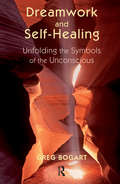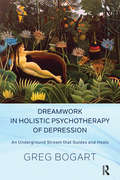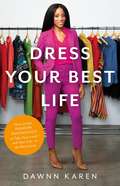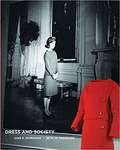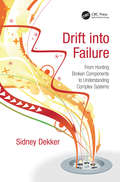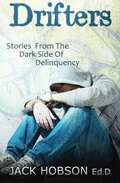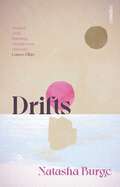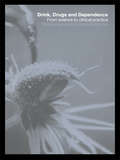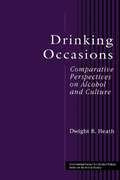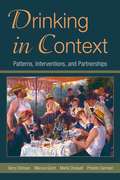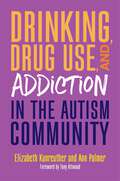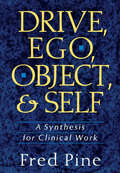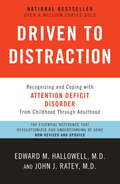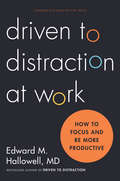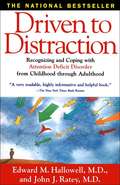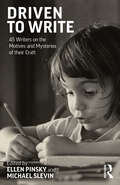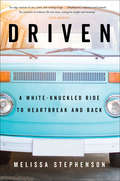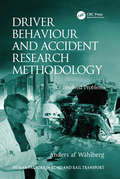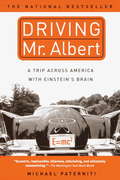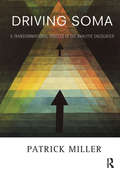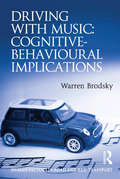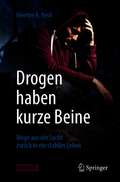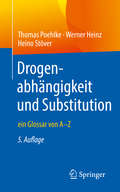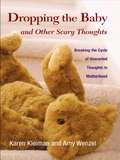- Table View
- List View
Dreamwork and Self-Healing: Unfolding the Symbols of the Unconscious
by Greg BogartThere have been many previous books on the physiology of dreaming, the history of dream interpretation, and the meaning of specific dream symbols. But there have been relatively few books exploring the moment-by-moment process of interpreting dreams. This book guides you through this interpretive process, and illustrates how dreamwork promotes emotional, relational, and spiritual transformation. It explores how working with dreams enhances our emotional life, deepens our capacity for relationship, and helps us gracefully navigate change and transitions. The author shows that dreamwork is a natural antidepressant, is effective in transforming anger, bereavement, couples conflicts and impasses, and aids the process of individuation. The book explores archetypal themes and complexes, synchronistic experiences and spiritual awakening in dreams, and representations of the body in dreams. The final chapter, "Taming Wild Horses", explores animal dream symbolism and its importance for enhancing our human sexuality. The book also describes the Dream Mandala, a method of self-transformation through the union of opposites - the charged polarities of the personality.
Dreamwork in Holistic Psychotherapy of Depression: An Underground Stream that Guides and Heals
by Greg BogartThis book describes how dreamwork can help alleviate depression, in both long-term and time-limited psychotherapy, and in self-treatment. The author shows how dreams shed light on issues contributing to depression-including drug and alcohol abuse, divorce, death and bereavement, conflicts about sex, health and body image, parenting, workplace stress and burnout, and ancestral, intergenerational trauma. Greg Bogart presents a synthesis of Jungian and existential psychotherapy, detailing how attention to archetypal symbolism brings into immediate focus new responses to pressing life challenges. He shows that allowing oneself to be affected by dream images and narratives promotes emotional, relational, and spiritual rejuvenation.
Dress Your Best Life: How to Use Fashion Psychology to Take Your Look -- and Your Life -- to the Next Level
by Dawnn KarenHarness the power of your wardrobe to achieve your dreams with this timely take on personal style from a world-renowned fashion psychologist.You may get dressed every day without really thinking about what you're putting on, but did you know that what you wear has a powerful effect on how you feel? Or that your clothes influence the way others perceive you? By making a few adjustments to your wardrobe, and learning to style from the inside out, you'll not only elevate your look, but level up your entire life. Dawnn Karen is a pioneer in the field of fashion psychology, and she has spent years studying the relationship between attire and attitude. In Dress Your Best Life she goes far beyond well-known makeover advice, pushing you to ask yourself: Are my clothing choices hurting me or helping me to achieve my life goals? Her book will help you discover your unique style story, become a smarter shopper, use color to your advantage, match moods to clothing choices, and embrace new or different standards of beauty. This knowledge is a power that you'll exercise every time you open your closet door or walk into an important meeting in just the right outfit.Packed with practical tips and cutting-edge advice, Dress Your Best Life will teach you to harness the power of fashion for the life you want to live.
Dress and Society
by Jane E. Workman Beth W. FreeburgUnderstanding the social expectations and meanings associated with dress is critical to a successful career in fashion. Just as critical is familiarity with research techniques to capture the history of fashion trends. Dress and Society fulfills these requirements by presenting a sociological perspective on how people dress and a research perspective on how to develop and appreciate research skills. Analyzing dress as an individual social behavior enables students to draw connections between their own lives and different styles of dress. Concepts such as gender, religion, race, education, cultural norms, and violations of cultural norms are thoroughly discussed. By starting each chapter with a headline from mass media, engaging the students in lively discussion, and presenting research with practical applications, the content becomes enjoyable and memorable for students.
Drift into Failure: From Hunting Broken Components to Understanding Complex Systems
by Sidney DekkerWhat does the collapse of sub-prime lending have in common with a broken jackscrew in an airliner’s tailplane? Or the oil spill disaster in the Gulf of Mexico with the burn-up of Space Shuttle Columbia? These were systems that drifted into failure. While pursuing success in a dynamic, complex environment with limited resources and multiple goal conflicts, a succession of small, everyday decisions eventually produced breakdowns on a massive scale. We have trouble grasping the complexity and normality that gives rise to such large events. We hunt for broken parts, fixable properties, people we can hold accountable. Our analyses of complex system breakdowns remain depressingly linear, depressingly componential - imprisoned in the space of ideas once defined by Newton and Descartes. The growth of complexity in society has outpaced our understanding of how complex systems work and fail. Our technologies have gotten ahead of our theories. We are able to build things - deep-sea oil rigs, jackscrews, collateralized debt obligations - whose properties we understand in isolation. But in competitive, regulated societies, their connections proliferate, their interactions and interdependencies multiply, their complexities mushroom. This book explores complexity theory and systems thinking to understand better how complex systems drift into failure. It studies sensitive dependence on initial conditions, unruly technology, tipping points, diversity - and finds that failure emerges opportunistically, non-randomly, from the very webs of relationships that breed success and that are supposed to protect organizations from disaster. It develops a vocabulary that allows us to harness complexity and find new ways of managing drift.
Drifters: Stories From the Dark Side of Delinquency
by Jack Hobson Ed.D.The world has changed… Teenagers exist in a different world than you grew up in. Video games, gun violence, sexting, and bullying have all exploded onto the scene, leaving many parents shut off from their children and vice versa. In that vacuum, too many kids gravitate toward darker temptations, but there is hope. You are not alone. <p><p>Come behind the scenes and walk the halls with school resource officer Jack Hobson, Ed.D. Firsthand he witnessed the scenarios that caused good students to turn bad or troubled teens to clean up their act. Sometimes, the difference could be a few simple words from the right person to stop the dangerous drift toward delinquency or worse. Some students drifted back. Others did not. These are their stories.
Drifts
by Natasha BurgeA strikingly original memoir of autism and transcultural identity, Drifts takes us through the souks, sands and cities of the Arabian Gulf, where the author is a native-born foreigner, to discover a new mapping of the self and celebrate the many stories a place can hold.'Surreal, vivid, haunting, mischievous, visionary' - Lauren Elkin 'Drifts is a stunning achievement. It invites us to see the world differently, as if through a kaleidoscope for the first time' - Hassan Melehy 'This is wonderful - we encounter not only the Gulf War and the falling Twin Towers of Manhattan but also London, Bahrain, Texas, Dhahran, souqs, sandstorms, slantways Arabic, and cats with weeping eyes. Read on. Drift on' - John Schad Natasha Burge was born and grew up in Saudi Arabia, where her family lived for more than half a century. Through various departures and returns - a year at boarding school in New England, university in London, a small town in Texas where there are more cows than people, back to work in Bahrain - the years of difficulty, isolation and severe anxiety take their toll. Finally, at 37 years old she received the life-changing news that she is autistic. In this striking exploration of identity and place, Burge probes these intertwined strands of her being: what it means to grow up at the interstices of different cultures, and what it is to experience unrecognised neurodivergence and a late diagnosis of autism. From the cosmopolitan heritage of Muharraq's Pearling Path to the jebels of Saudi Arabia's Eastern Province, Burge charts a new course through the stories of the Arabian Gulf and the myths surrounding autism. The result is a work of dazzling insight, sensitivity and awareness.
Drink, Drugs and Dependence: From Science to Clinical Practice
by Woody Caan Jackie De BellerocheAt a world level addiction and the fall-out from substance use is affecting more and more lives. Professionals are increasingly being confronted with puzzling, multifaceted aspects of substance use, whether they work in a clinic, the laboratory or the community.If you are a member of any caring profession, sooner or later you will encounter problems caused by drugs, alcohol and tobacco. In order to understand substance use and substance users, no single discipline can provide all the answers. In a novel way, this book integrates biological science, social science and clinical experience. It draws together contributions from experts in these diverse and rapidly growing fields, providing the reader with a deeper capacity to engage with problems effectively.Drink, Drugs and Dependence includes thought-provoking examples, illustrations and test questions to support problem-based learning. Designed to be read consecutively or as a reference text, it will be a welcome resource for all those working in the field of addiction.
Drinking Occasions: Comparative Perspectives on Alcohol and Culture (ICAP Series on Alcohol in Society)
by Dwight B. HeathThe main purpose of this book is to describe the variety of drinking occasions that exist around the world, primarily in modern, industrialized countries. As such, it celebrates the diversity of normal drinking behavior and illustrates a wide range of beneficial drinking patterns. Attention is also paid to the relations between drink and culture that prevail in non-Western societies and in developing countries. The aims of the book are twofold: to deal directly with the challenge of how to define responsible drinking in the face of the world's many different drinking styles, and to portray the many ways in which people have thought about or used alcohol as an integral part of their culture
Drinking from the Trough: A Veterinarian's Memoir
by Mary CarlsonMary Carlson didn't start out to become a veterinarian, let alone the owner and caretaker of cats (many), dogs (two, both huskies), and horses (some with manners, some without) in Colorado. She was a suburban Chicago girl; all she knew of the American West came from the stories her uncle, who had settled in northern Colorado, told her during his annual visits. But thanks to him, she ended up moving to Fort Collins, Colorado for college—and after falling in love with a man she'd become friends with in her final year of college, when he was a student at the CSU School of Veterinary Medicine, she remained there. Watching the work Earl did as a veterinarian inspired Mary to eventually leave her tenured teaching position and enter vet school, after which she opened her own, feline-exclusive clinic. Along the way, there were numerous pets, grueling years of vet school, a shattered hip, an enduring love, illness, and death—and the rediscovery that life, especially a life full of delightful animals, is worth living.
Drinking in Context: Patterns, Interventions, and Partnerships
by Marcus Grant Gerry Stimson Marie Choquet Preston GarrisonDrinking beverage alcohol is a widespread source of individual and social pleasure in most countries around the world. Yet, some drinking patterns can lead to serious physical, mental, and social harms. Drinking in Context is intended to complement existing volumes dealing with international alcohol policy by focusing on three main themes: drinking patterns, targeted interventions, and partnership development. An understanding that patterns of drinking are important predictors of outcomes has led to a growing realization that alcohol policies and prevention strategies need to focus on excessive or irresponsible drinking. As a result, there has been a shift towards interventions that address the targeted reduction of harm. These approaches recognize socio-cultural differences and avoid trying to impose a one-size-fits-all solution. In this context, multi-stakeholder partnerships offer an excellent opportunity to promote the complex mix of measures required by each society. Shared responsibilities lead to shared solutions.
Drinking, Drug Use, and Addiction in the Autism Community
by Tony Attwood Ann Palmer Elizabeth KunreutherWhat is the connection between autism and addiction? Why are individuals with autism more likely to develop a substance use disorder than the general population? Until recently, substance use disorder (SUD) was considered rare among those with autism spectrum disorder (ASD). This book brings together current research and personal accounts from individuals with autism and their supports. It explores why addiction is more common among individuals with ASD and investigates how addiction and autism affect one another. The authors also provide strategies for supporting people with both ASD and SUD.
Drive, Ego, Object, And Self: A Synthesis For Clinical Work
by Fred PineIn this important new book, the noted theoretician Fred Pine provides a synthesis of the four conceptual domains of psychoanalysis: drives, ego functioning, object relations, and self experience. He argues that a focus on the clinical phenomena themselves, and not on the theoretical edifices built around them, readily illuminates the inevitable integration of the several sets of phenomena in each person's unique psychological organization.With superb clarity, Pine shows how one or another or more of these becomes central to a particular individual's psychopathology. Drawing on a wealth of detailed clinical material-brief vignettes, process notes of sessions, and full analyses-he vividly demonstrates how a broad multimodel perspective enhances the treatment process, and is, in fact, its natural form. He also applies these ideas to such crucial clinical issues as preoedipal pathology and ego defect, the so-called symbiotic phase, and the mutative factors in treatment. Conceptually elegant and immensely practical, this highly original work is certain to be, in the words of Arnold Cooper, "a guide for theorists and clinicians for many years to come."
Driven to Distraction (Revised): Recognizing and Coping with Attention Deficit Disorder
by Edward M. Hallowell John J. RateyGroundbreaking and comprehensive, Driven to Distraction has been a lifeline to the approximately eighteen million Americans who are thought to have ADHD. Now the bestselling book is revised and updated with current medical information for a new generation searching for answers. Through vivid stories and case histories of patients—both adults and children—Hallowell and Ratey explore the varied forms ADHD takes, from hyperactivity to daydreaming. They dispel common myths, offer helpful coping tools, and give a thorough accounting of all treatment options as well as tips for dealing with a diagnosed child, partner, or family member. But most importantly, they focus on the positives that can come with this &“disorder&”—including high energy, intuitiveness, creativity, and enthusiasm.
Driven to Distraction at Work: How to Focus and Be More Productive
by Edward M. HallowellAre you driven to distraction at work? Bestselling author Edward M. Hallowell, MD, the world’s leading expert on ADD and ADHD, has set his sights on a new goal: helping people feel more in control and productive at work. You know the feeling: you can’t focus; you feel increasingly overwhelmed by a mix of nonstop demands and technology that seems to be moving at the speed of light; and you’re frustrated just trying to get everything done well-and on time. Not only is this taking a toll on performance, it’s impacting your sense of well-being outside the office. It’s time to reclaim control. Dr. Hallowell now identifies the underlying reasons why people lose their ability to focus at work. He explains why commonly offered solutions like "learn to manage your time better” or "make a to-do list” don’t work because they ignore the deeper issues that are the true causes of mental distraction. Based on his years of helping clients develop constructive ways to deal with distraction, Dr. Hallowell provides a set of practical and reliable techniques to show how to sustain a productive mental state. In Part 1 of the book, he identifies the six most common ways people lose the ability to focus at work-what he calls "screen sucking” (internet/social media addiction), multitasking, idea hopping (never finishing what you start), worrying, playing the hero, and dropping the ball-and he explains the underlying psychological and emotional dynamics driving each behavior. Part 2 of the book provides advice for "training” your attention overall, so that you are less susceptible to surrendering it, in any situation. The result is a book that will empower you to combat each one of these common syndromes-and clear a path for you to achieve your highest personal and professional goals.
Driven to Distraction: Recognizing and Coping with Attention Deficit Disorder from Childhood through Adulthood
by Edward M. Hallowell John J. RateyThrough vivid stories of the experiences of their patients (both adults and children), Drs. Hallowell and Ratey show the varied forms ADD takes and the transforming impact of precise diagnosis and treatment.
Driven to Write: 45 Writers on the Motives and Mysteries of their Craft
by Ellen Pinsky Michael SlevinIn this book of essays, over 40 successful writers in varied fields —poetry, science, the performing and visual arts, psychoanalysis, journalism, literature and more— explore what drives them to write, and to work at their craft.In contributions arranged under three headings— “Models and Mentors,” “Urges and Traumas,” and “Evidence and Experiences”—each writer explores their personal understanding of writing as a psychological necessity. In varying ways, these candid, often emotional essays reveal a range of intimate, mysterious and unpredictable purposes and motivations.Driven to Write provides fresh, practical, and imaginative approaches to literary art for aspiring and established writers alike.
Driven: A White-Knuckled Ride to Heartbreak and Back
by Melissa StephensonFor fans of Wild, a searing memoir about one woman’s road to hope following the death of her troubled brother, told through the series of cars that accompanied her Growing up in a blue-collar family in the Midwest, Melissa Stephenson longed for escape. Her wanderlust was an innate reaction to the powerful personalities around her, and came too from her desire to find a place in the world where her artistic ambitions wouldn’t be thwarted. She found in automobiles the promise of a future beyond Indiana state lines. From a lineage of secondhand family cars of the late ’60s, to the Honda that carried her from Montana to Texas as her new marriage disintegrated, to the ’70s Ford she drove away from her brother’s house after he took his life (leaving Melissa the truck, a dog, and a few mixed tapes), to the VW van she now uses to take her kids camping, she knows these cars better than she knows some of the people closest to her. Driven away from grief, and toward hope, Melissa reckons with what it means to lose a beloved sibling.Driven is a powerful story of healing, for all who have had to look back at pain to see how they can now move forward.
Driver Behaviour and Accident Research Methodology: Unresolved Problems (Human Factors in Road and Rail Transport)
by Anders af WåhlbergThis book discusses several methodological problems in traffic psychology which are not currently recognized as such. Summarizing and analyzing the available research, it is found that there are a number of commonly made assumptions about the validity of methods that have little backing, and that many basic problems have not been researched at all. Suggestions are made as to further studies that should be made to address some of these problems. The book is primarily intended for traffic/transport researchers, but should also be useful for specialized education at a higher level (doctoral students and transportation specialists) as well as officials who require a good grasp of methodology to be able to evaluate research.
Driving Mr. Albert
by Michael PaternitiAlbert Einstein's brain floats in a Tupperware bowl in a gray duffel bag in the trunk of a Buick Skylark barreling across America. Driving the car is journalist Michael Paterniti. Sitting next to him is an eighty-four-year-old pathologist named Thomas Harvey, who performed the autopsy on Einstein in 1955 -- then simply removed the brain and took it home. And kept it for over forty years. On a cold February day, the two men and the brain leave New Jersey and light out on I-70 for sunny California, where Einstein's perplexed granddaughter, Evelyn, awaits. And riding along as the imaginary fourth passenger is Einstein himself, an id-driven genius, the original galactic slacker with his head in the stars. Part travelogue, part memoir, part history, part biography, and part meditation, Driving Mr. Albert is one of the most unique road trips in modern literature.
Driving Soma: A Transformational Process in the Analytic Encounter
by Patrick MillerPlunged into the experience of an analytic session, analysand and analyst can come closer to what Freud terms the "primary processes". A clear-cut distinction between body and mind tends to become blurred while the bodily-egos of both protagonists are more effectively present to each other. How deeply can they affect each other, and can the transformational working through of the drives give access to potential transformations not only within the dimension of the erogeneous body but also of the soma? This book explores these complex issues from a number of different perspectives: the clinical approach of patients with somatic diseases; the metapsychology of the analyst at work, including different aspects and functions of formal regression; the function of figurability of certain bodily enactments; the specific use the analyst can make of his own subjectivity (relationship between subjectivity and neutrality) and how this leads to a specific way of thinking about intersubjectivity in psychoanalysis; and the way in which some works of art can enrich how we confront the body-mind-soma issue in our analytic experiences with our patients.
Driving With Music: Cognitive-behavioural Implications (Human Factors in Road and Rail Transport)
by Warren BrodskyThis book, the first full-length text on the subject, explores the everyday use of music listening while driving a car. It presents the relationship between cars and music in an effort to understand how music behaviour in the car can either enhance driver safety or place the driver at increased risk of accidents. A great deal of work has been done to investigate and reduce driver distraction and inattention, but this book is the first to focus on in-cabin aural backgrounds of music as a contributing factor to human error and traffic violations. Driving With Music begins by outlining the automobile, its relationship to society, and the juxtaposition of music with the automobile as a complete package. It then highlights concepts from the fields of music perception and cognition, and, within this framework, looks at the functional use of background music in our everyday lives. Driver music behaviours - both adaptive and maladaptive - are explored, with the focus on contradictions and ill-effects of in-car music listening. To conclude, implications, applications and countermeasures are suggested.
Drogen haben kurze Beine: Wege aus der Sucht zurück in ein stabiles Leben
by Nevriye A. YesilDrogen haben kurze Beine! Sie lügen jedes Mal von Neuem und vermitteln Gefühle, Emotionen und Eindrücke, die nicht echt sind. Und obwohl nicht echt, erschaffen sie eine körperliche und psychische Abhängigkeit.Dieser Ratgeber bietet Menschen mit einer Drogensucht und deren Angehörigen wichtige Fakten rund um das Thema Drogen und Abhängigkeit und zeigt psychologische Wege und Methoden auf, von der Sucht loszukommen. Dieses Buch klärt über verschiedene Substanzen auf – von Medikamenten, Alkohol und Nikotin bis hin zu illegalen Drogen wie Kokain und Heroin –, motiviert und begleitet bei der Entscheidung, sich von Drogen zu lösen. Es bietet hilfreiche Tipps und Methoden zur Rückfallprävention und zeigt, wie Angehörige bei der Bekämpfung einer Sucht helfen können.
Drogenabhängigkeit und Substitution: ein Glossar von A–Z
by Heino Stöver Thomas Poehlke Werner HeinzEin Glossar zur Substitutionstherapie bei Drogenabhängigkeit braucht jeder Arzt, der opiatabhängige Patienten behandelt, jeder interessierte Apotheker und jeder, der Drogenabhängige betreut. In der vierten Auflage wurden die Inhalte des im Substitutionsalltag oft genutzten Bandes aktualisiert und um einige Begriffe erweitert. Dem interessierten Leser ist zu wünschen, dass ihm auch diesmal eine rasche Orientierung in diesem komplexen und durch vielfältige juristische und medizinische Vorgaben begrenzten Bereich der Suchtmedizin gelingt.
Dropping the Baby and Other Scary Thoughts: Breaking the Cycle of Unwanted Thoughts in Motherhood
by Amy Wenzel Karen KleimanWhat if I drop my baby when I go down the steps? What if I burn the baby in the bathtub? Thoughts like these can be frightening to new mothers, but are a common symptom pregnant and postpartum women can experience. Dropping the Baby and Other Scary Thoughts addresses the nature of these intrusive, negative and unwanted thoughts. Kleiman and Wenzel offer answers to the women who seek information, clarification, and validation in this useful resource for healthcare professionals working with these mothers. Written by two clinicians who have established themselves as leading experts and authors in this specialized field, this book maintains a compassionate tone that will be a voice familiar to many women in the postpartum community. Whether you must confront these negative notions personally or in your practice, this book will explain what these thoughts are, why they are there, and what can be done about them.
